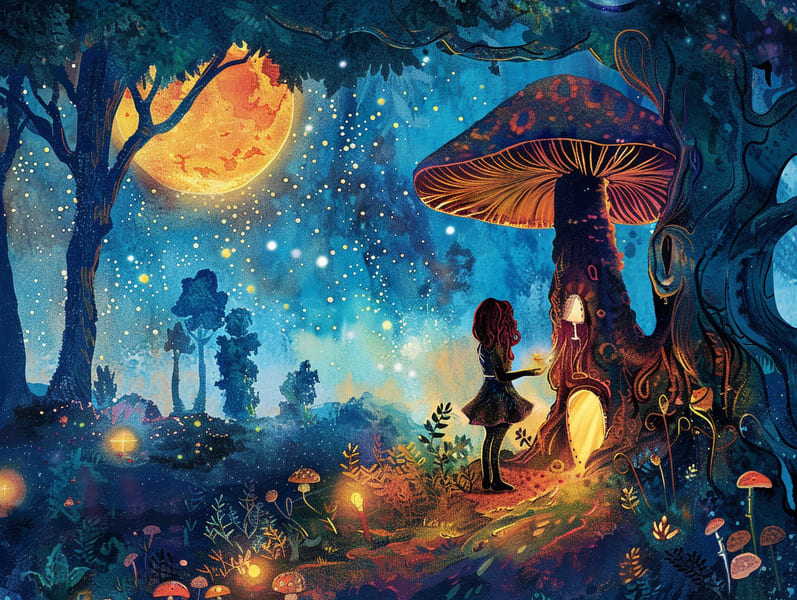
Confronting Usual Fears with Engrossing Tales
Fear of Insects and Arachnids
Tales often highlight characters who first are afraid of insects or spiders but get to know to appreciate their importance in nature through magical journeys. These narratives assist children in shifting their viewpoints, changing fear towards curiosity and appreciation. By going through fantastical quests and encounters with kindly bug characters, children discover that these creatures are not as scary as they appear. These stories are ideal for children dealing with entomophobia (the more info fear of insects) and arachnophobia (fear of spiders).Anxiety of Separation
Narratives addressing separation worries present comforting scenarios where figures gain bravery and confidence during experiences of separation from their loved ones. These stories are suitable for nighttime, providing comfort and security. By seeing characters successfully navigate separation, children understand their own situations mirrored in the stories and understand how to cope to deal with their emotions. These stories support children who have the difficulty of separation.Darkness Phobia
Many children struggle with a ndisya of darkness, and stories that transform this typical fear into exciting night-time quests become incredibly comforting. Figures might embark on journeys under the stars or find out about the beauty and mystery of the night, enabling children to view the dark as a place of adventure rather than a source of fear. This reframing helps to ease nighttime tensions and promote better sleep. These narratives are perfect for children with nyctophobia and assist them feel more comfortable at night.Facing Loud Noises
When it comes to youngsters that are frightened due to high-volume noises, fables that introduce these sounds in a structured storyline can assist.
Characters may face thunder storms and noisy festivities and find ways to handle the sound.
These fables could teach children that noisy events are common so they are not scary.
Such tales can benefit youngsters with phonophobia (fear of high-volume sounds).
Narratives of Animals
Narratives featuring friendly animal characters could help kids to overcome fears of certain animals.
By following the path of a figure who becomes friends with an animal that was once feared, children shall learn to view these creatures with empathy.
Such tales could aid children with zoophobia (fear of certain animals), helping them become more comfortable around pets and other animals.
Narratives of Doctors
Children who feel anxious about seeing doctors can benefit from stories showing medical professionals kindly and helpfully.
Figures may go on fantastical adventures and learn to trust and value doctors.
Such stories aid in reducing anxious feelings about medical visits.
These fables are extremely useful for kids with iatrophobia (fear of medical practitioners).
Adventures in Heights
For children scared of heights, adventures involving characters mountain climbing or exploring tall buildings may be helpful.
These fables generally include companions and magical elements, making the journey more approachable and thrilling.
Such narratives are helpful for children with acrophobia (fear of tall heights).
Narratives of Needles
Narratives concerning fear of injections usually involve protagonists gaining bravery by way of magical or daring quests.
These adventures could help kids know that needles aren't too dangerous, and that they can deal with their fears bravely.
These adventures can be helpful for kids with trypanophobia (fear of needles).
Tales involving Water
For children who are afraid of water, narratives featuring swimming adventures or lake adventures can be very effective.
Characters sometimes find enchanted items or come across amiable creatures that help them to overcome the fear and love the water.
Such stories can assist young readers with aquaphobia (fear of water).
Overcoming Monster Fears
Adventures that turn beasts into amicable or misconceived characters can aid youngsters get over their fear of imaginary creatures. These types of tales often involve evening escapades where characters discover to regard monsters as companions other than threats, aiding to alleviate sleep-time anxieties. These types of stories are perfect for kids who are scared of imaginary creatures, often referred to as beast phobia phobia.
Magic & Adventure in Children's Tales
Enchanted Adventures
Many tales include elements of fantasy and journey, transforming the process of confronting dreads an thrilling quest. Figures often undertake adventures to find mystical things or solve riddles, confronting and conquering their phobias along the process. This approach allows youngsters to face their worries from a distance, creating a comfortable gap while still addressing the fundamental concerns.
Animal Support
Protagonists often are accompanied by creature allies who support them with their challenges. These creature allies function as both protectors and guides, making the adventures more understandable and soothing for kids. The inclusion of a faithful buddy in the narrative can signify the network of support youngsters have in the own lives, strengthening the concept that one is not solitary in dealing with their worries.
Interactive Parts
Reading parts and cadenced passages turn these tales ideal for interactive storytimes. This engagement not only render the adventures more entertaining but also strengthens the lessons they teach. Urging little ones to anticipate the ending or reproduce figures' actions can increase their connection to the tale and its message. Participative narrative telling can also improve a kid's perception of agency, making them proactive members in the own journey to surpass anxiety.
Conclusion: Embracing the Healing Power of Stories
The meticulously created narratives at Lionheart Narratives give more than just entertainment—they give a comforting experience that can assist children process and surpass their anxieties. By presenting identifiable figures and magical tales, such tales empower youngsters to confront their worries with valor and tenacity. As someone with a background in psychology, I have realised these narratives to be invaluable methods in encouraging emotional strength and helping kids navigate the obstacles they face.
Inspiring your offspring to explore these life-changing stories and see the charm of tales as it leads them through their fears and phobias. Whether coping with the apprehension of bugs, spiders, being apart, darkness, or other typical phobia of childhood, these narratives offer expectation, insight, and a route to emotional resilience.
For more information and to uncover these amazing adventures, visit Lionheart Storyz.